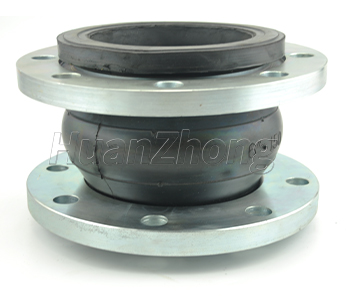Different rheological properties of rubber and thermoplastic plastics (rubber joint with rubber as the purpose of the elastic material), in that. From the point of mechanical properties and rheological properties, natural polymers and synthetic polymers can be divided into two categories, the amorphous polymer (rubber joint used rubber material belongs to this type of material) and crystallization of polymer. The former has three physical state, glassy state, high elastic and viscous flow states; there is no obvious temperature between three states transition point, while the latter only exist in crystal phase and the liquid phase, obvious melting point. Rubber belongs to the amorphous polymer, although some rubber, neoprene and butyl rubber to fractional crystallization (this kind of rubber materials and rubber joint can meet the requirements of special applications).Polyethylene, polypropylene and nylon as the crystalline polymer, its melting point is 110 degrees, 170 degrees, 260 degrees. Crystalline polymer processing under the molten state, the rubber does not. Due to all kinds of rubber structure completely amorphous or low crystallinity, before the transition to a molten state, i.e. in partial or complete the high elastic state to processing, processing condition of 80 degrees to 80 degrees and shear rate v for 10 to 100.At this point, the viscosity is about 1000 to 10000 pa, and the elasticity and adhesion friction properties are obvious. Containing carbon black rubber also show the thixotropy and solid properties (yield point and boundary activities, etc.).Because of mixing rubber vulcanizing agent and accelerator, is contained in it and thermoplastics, processing temperature not too high, the ceiling is usually between 110 and 115 degrees. Rubber processing temperature should be in from playing too high to make the transition to viscous flow range, usually about 100 degrees. For crystalline polymers (such as polyethylene, polyamide, etc.), the temperature range, in fact, there are none (no more than 10 to 20 degrees).
Compared with plastic, rubber and molecules in a molecular inter-atomic forces weak (flexible rubber joint strength and molecular flexibility, and low glass transition temperature Tg. If the glass transition temperature Tg and viscous flow temperature interval said Tt raw rubber mixing rubber processing temperature range, and then the rubber joint material processing temperature range is much wider than plastic, and rubber joint elastic deformation of the rubber is much higher.
Rubber joint displacement function is associated with the rheological properties of rubber, rubber rheological properties mainly depends on the molecular parameters of rubber, such as the chemical structure, molecular weight, molecular weight distribution, degree of branching and crosslinking degree, etc., as well as with various additives (such as reinforcing agent and plasticizer application) and processing conditions (such as temperature and speed of processing machinery, etc.).So the rubber, especially mixed gel rheological behavior of the multicomponent system is a complex subject. In terms of processing, rubber and rubber material rheological properties of graduate students and is the research on the rheological properties of the above factors influence; And affect the performance of rubber processing rheological properties, it is generally believed mainly include viscosity, elasticity easily, raw rubber fracture properties and adhesion friction properties.
